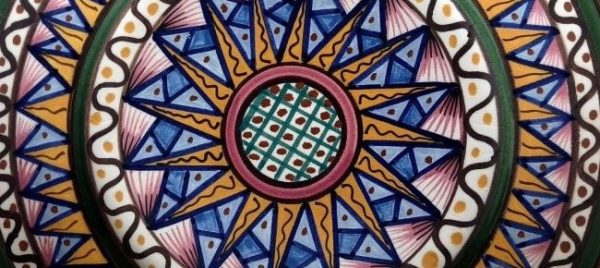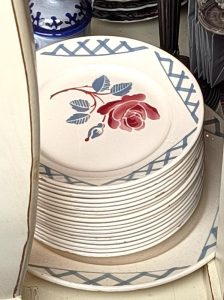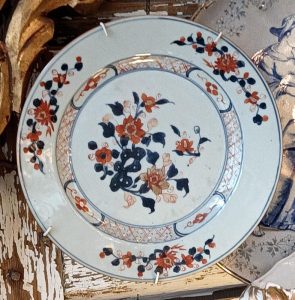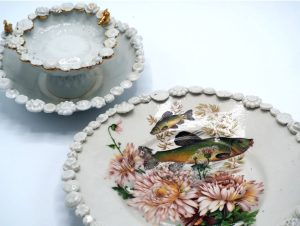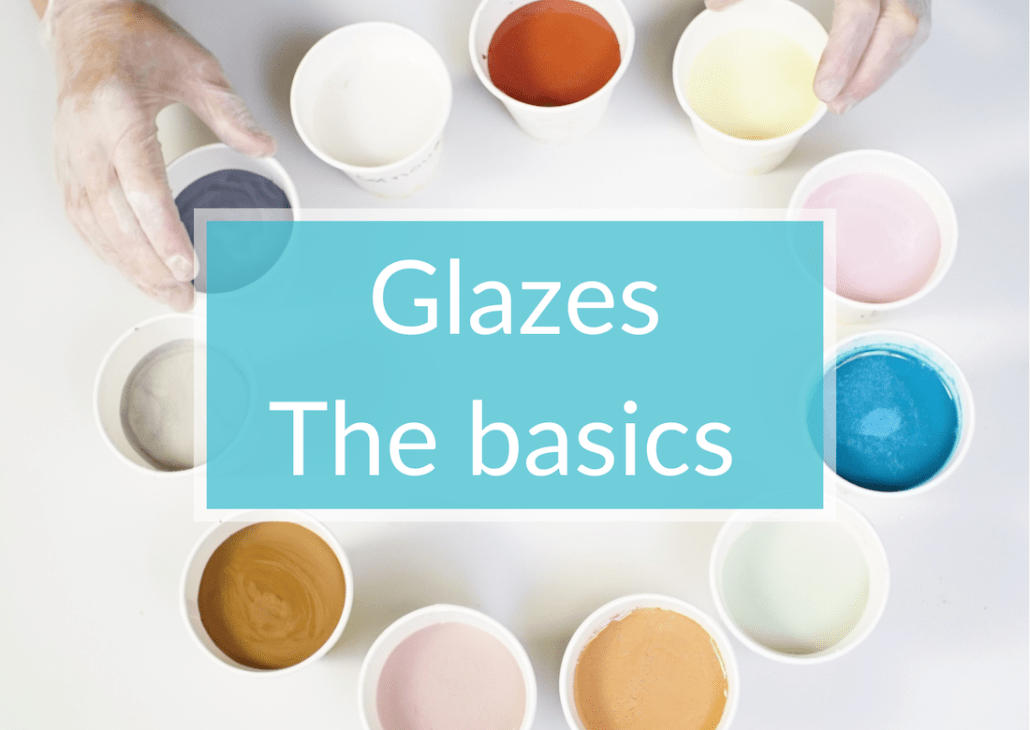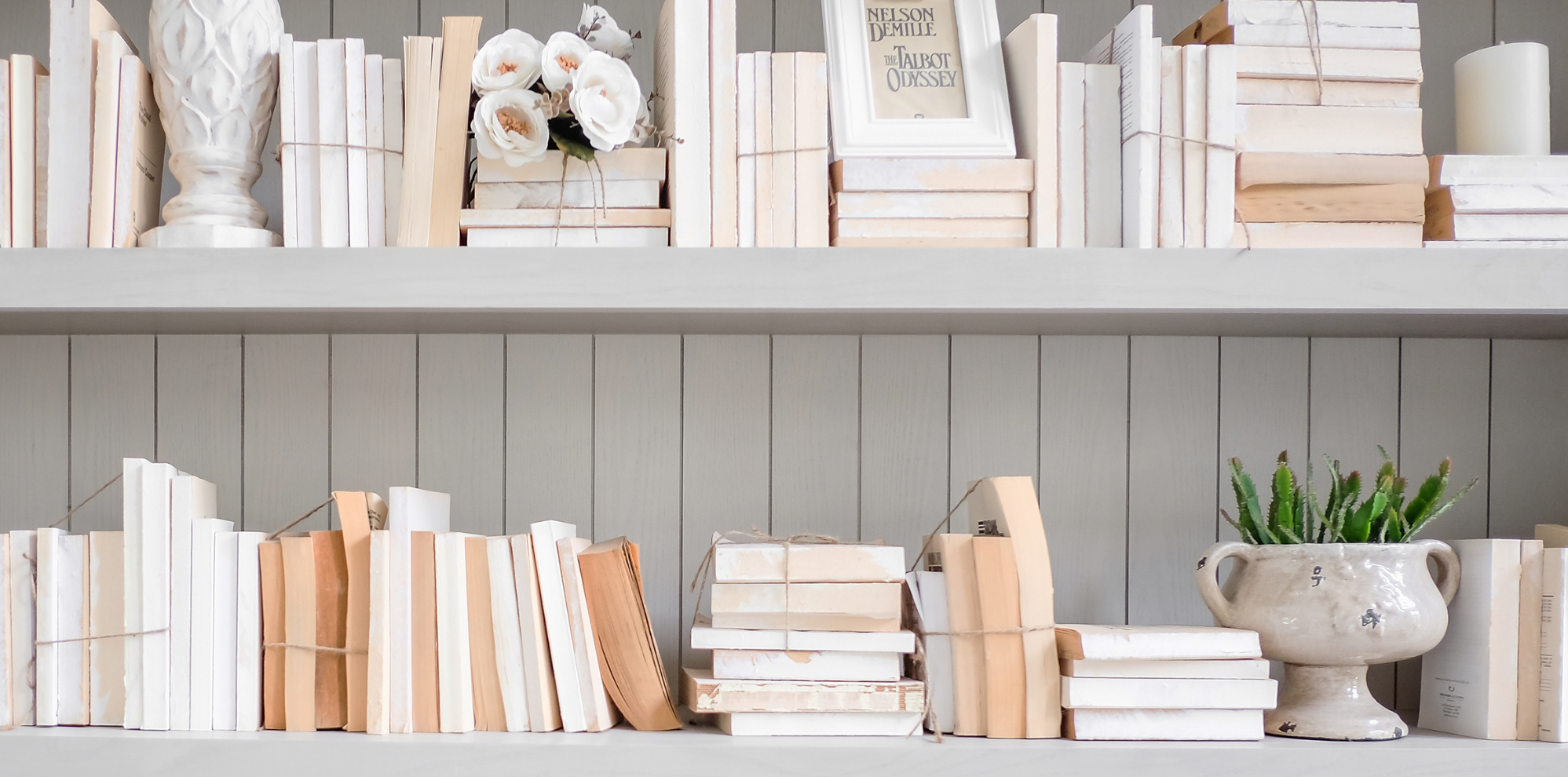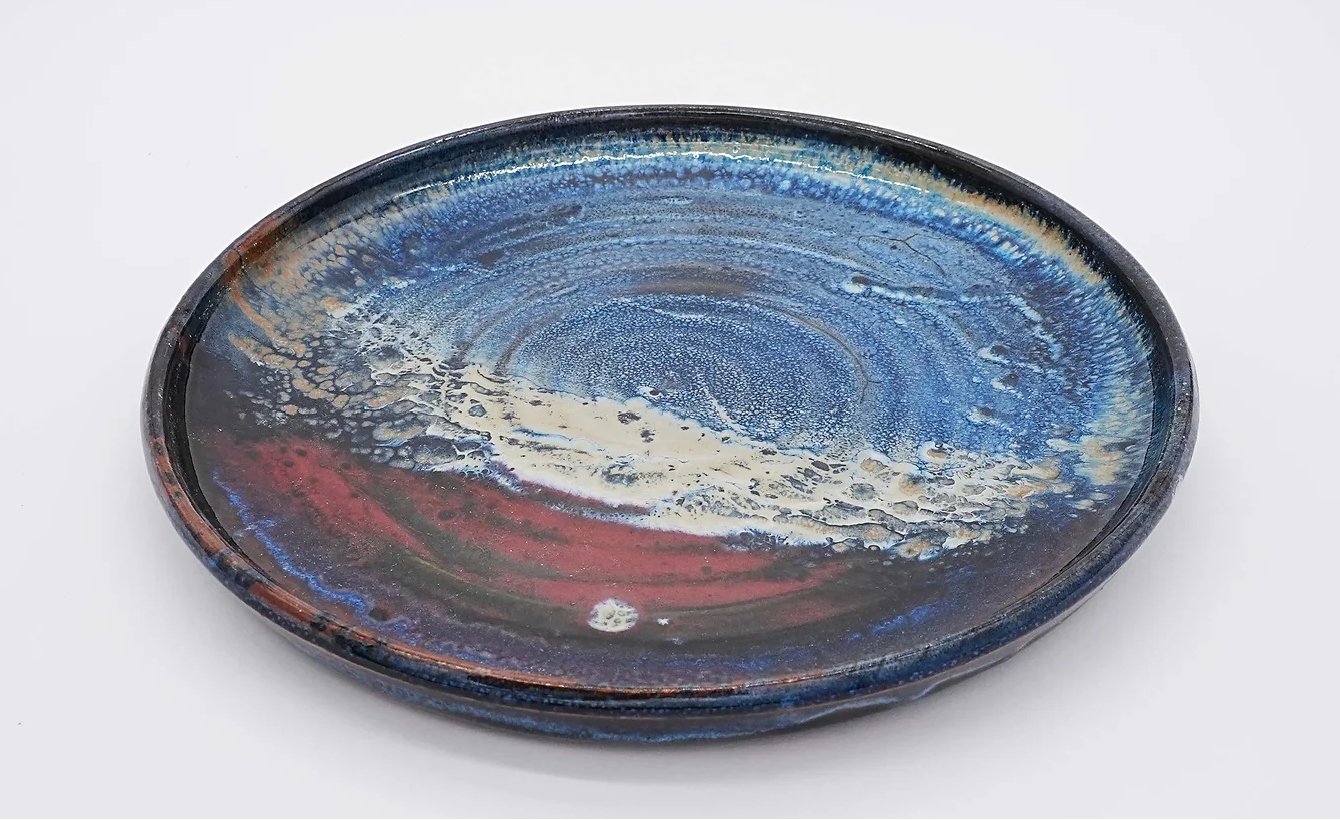The success of antique tableware
Contents
- Why is vintage tableware so popular?
- Challenges for modern ceramicists
- Strategies for adding value to simpler, more sober pieces
- Marketing contemporary ceramics
Introduction
The resonance of inanimate objects
Vintage tableware, with its timeless charm, is enjoying a spectacular revival. Flea markets, online sales, and charity shops are experiencing unprecedented interest in our grandmothers’ plates, tureens, and other ceramics. This resurgence of enthusiasm for older pottery is not limited to those who love retro decor, but attracts a wider audience, including the younger generation. The appeal of vintage tableware is based on three main elements: nostalgia, authenticity and durability.
What challenges does this pose for contemporary ceramics? How do we respond to this change in taste, while maintaining our own, individual creative path? At the end of this article, we’ll talk about how to use storytelling to promote our own modern work.
Why is vintage tableware so appealing?
Nostalgia for a bygone era
Several factors explain the growing appeal of vintage tableware, but the first is clearly its nostalgic appeal. Searching for unique pieces brings back childhood memories, from an era when family meals were special occasions.
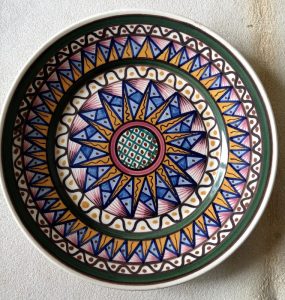
Earthernware HB Quimper, early XXe
Responsible consumption
There is a wider interest in responsible consumption and sustainability. More and more consumers prefer to hunt for objects that already have a history rather than buying newly made ones, reducing waste by promoting reuse.
An appeal that spans generations
Young people in particular are drawn to the charm and originality of antique tableware. The floral ceramics that once filled their grandparents’ china cabinets are finding new life on today’s tables. Older generations see it as a way to reconnect. Some restaurants use antique pieces, providing a special dining experience.
In short, this vintage revival reflects a search for meaning in our everyday consumption.
But those people who are interested in retro ceramics are not necessarily the same as those who frequent potters’ markets. Vintage pottery enthusiasts often use flea markets and online sales to find antique pieces, while visitors to potters’ markets are looking for unique, contemporary, artisanal creations.
Challenges for the modern ceramicist
Decoration and colour
After years of minimalism, the enthusiasm for vintage pottery is especially animated by an interest in its decoration and colour. This represents both an opportunity and a challenge for ceramicists. For Creamik, a school that teaches making glazes, with a particular emphasis on colour, this development has a special resonance. It is at a potential meeting point between two audiences: those whose focus is on antique pottery, and those who seek contemporary artisanal pieces.
To follow the trend or pursue your own style?
Modern ceramicists often face two choices: to follow fashion to meet market demand, or to buck the trend and create a unique niche. This dilemma can be quite stressful. Conforming to current fashions may guarantee sales, but risks drowning the artist in a sea of similar products. On the other hand, standing out with bold, unique creations can attract a loyal and passionate clientele, but runs the risk of limiting oneself to a smaller market.
Nolwenn Bruneau’s work is an example of a successful blend of past and present: by incorporating elements of vintage pottery into her creations, she has made attractive pieces without sacrificing her artistic identity.
Imitating the old
Today’s fashions are not only inspired by the past, they often seek to imitate its style. This imitation poses a particular challenge to modern ceramicists, who must balance historical authenticity with contemporary techniques. Consumers want pieces which seem to have a history, even if they have just come out of the kiln.
For example, Jacques Monneraud, whose production is both contemporary and refined, has created a faithful replica of the trophy awarded to the winner of the Roland-Garros tennis tournament, the famous “Coupe des Mousquetaires” (Musketeers’ cup), whose shape recalls the cups of ancient Greece.
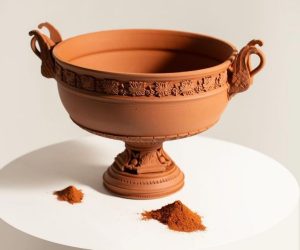
Jacques Monneraud
Maison Cuilleret offers collections of antique crockery as well as new pieces based on vintage models, combining contemporary manufacturing quality with period design. This blend of old and new is both aesthetically pleasing and functional.
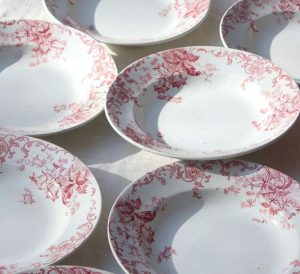
Maison Cuilleret
The return of the 70s
Vintage appeal isn’t just about Gien, Sarreguemines or HB Quimper; it’s also about the triumphant return of the 70s and its colourful, psychedelic decoration, its geometric patterns, bright colours and bold designs.
Strategies to add value to your production
Mixing vintage and modern
Ceramicists can use contrasting modern and vintage features. This approach can highlight the contemporary nature of the work, while adding a touch of history and authenticity. Monochrome modern pieces with simple, restrained shapes can be enhanced by retro elements with more elaborate patterns and vibrant colours.
Tips for pairing modern ceramics and vintage pieces
To make this combination a success, follow a few basic rules:
- Colour balance: Choose complementary colours or harmonious palettes to avoid harsh contrasts. For example, pairing contemporary white or grey ceramics with retro pastel pieces can create a visually pleasing effect.
- Interplay of textures: Mixing smooth, polished textures with rougher, patinated ones can add depth.
- A consistent theme: Even if the pieces are from different eras, try to maintain an overall theme that ties them together, whether it’s floral motifs, geometric shapes or minimalist styles.
The art of reclamation
Breizh Cottage is an excellent example of the art of elegant reclamation. On her website and Instagram account, Odile Deschamps shows how to make jewellery out of broken pieces of antique crockery. These can be assembled to create unique and charming pieces.
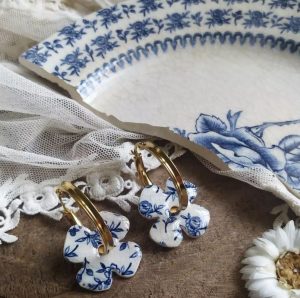
Breizh Cottage
A soap dish can become an accessory dish, a pitcher can be used as a vase. Retro ceramics become many varieties of decorative objects.
Marketing Contemporary Ceramics
Telling a story
Today, the mere quality of a product is not always enough. Telling a story, sharing the craftsman’s passion, forges an emotional bond with customers. By talking about the origin of materials or the inspiration behind a design, ceramicists bring their customers into their world.
The Power of Storytelling
Storytelling is powerful, even when spun around seemingly simple pieces. A perfect monochrome glaze requires a deep knowledge of chemistry. Explaining your long search for this particular tone communicates the full intensity and excitement of your craft. As for layering different glazes, potters can often be asked to describe their results. Here are three examples of how Matthieu describes the process when he exhibits:
Elegant flight in clay
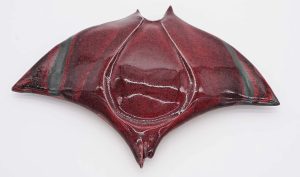
This stoneware wall sculpture captures the elegance and majesty of marine life.
Oxblood red, obtained from copper and lithium oxide in reduction, gives the piece a deep hue. This colour is a variation freely inspired by the extraordinary and rare beauty of pink manta rays.
The black background called “Entem” is Matthieu’s creation. It is composed of an engobe and a tenmoku glaze. Under the copper red, it creates an impression of movement and lightness reminiscent of the graceful motion of a manta ray in the ocean.
A harmonious blend of earth and water
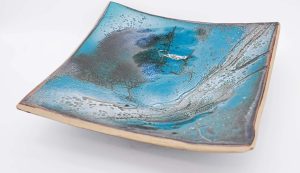
This large square bowl combines a modern, contemporary geometric shape with a play of predominantly natural and aquatic colours.
The superimposition of four different glazes creates a rich visual landscape. The first layer of tenmoku brings dark nuances evoking the depth of the earth. Ash blue and duck green, obtained with cobalt and chromium, recall the vibrant colours of the ocean, adding a touch of freshness and vitality.
White titanium and white zirconium add flashes of light and clarity, evoking foam crashing against rocks.
This large hollow bowl invites contemplation of the beauty of the natural world. It is suitable for table service, or as a decorative piece.
Luminosity and elegance in three dimensions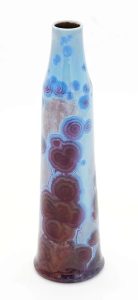
This mauve “soliflore” is a delicate expression of the art of crystallisation on porcelain. It links a classic form and innovative glazing technique.
The glaze, enriched with copper and cobalt, creates a palette of mauve, a colour that evokes both serenity and depth. This colour is the result of two successive firings, contributing to its richness and complexity.
A third firing using a lustre glaze is a masterful touch that gives a unique effect to the surface of the vase. This technique requires perfect control of the kiln.
This “soliflore” is not just a decorative object, it’s a piece that demonstrates Matthieu’s commitment to excellence, art and science.
Conclusion
Vintage tableware poses a challenge to 21st century ceramicists. How can we revisit the past while preserving its uniqueness? Using vintage pieces, rethinking their use, drawing inspiration from them, creating harmony between past and present… These are avenues for experimentation.
Let’s remember that ceramics is first and foremost an art. Fashion can guide and inspire, but the essence of this craft resides in individual inspiration. In the face of new trends and aggressive marketing, it’s important to distance oneself and maintain artistic integrity, as well as telling a story that sheds light on your creative process.
Whether you’re an amateur or a seasoned professional, don’t be afraid to experiment and find your own style. The potency of ceramics lies in its diversity and in the passion of its practitioners.
Bibliography
- TF1 Reportage : Pourquoi on raffole autant des assiettes de grand-mère ? https://www.tf1info.fr/conso/video-tf1-brocantes-vaisselle-de-meme-pourquoi-on-en-raffole-autant-des-assiettes-de-grand-mere-2289038.html
- BFM Reportage sur la vaisselle vintage
Vidéo en ligne, https://www.dailymotion.com/video/x8yf3uo - Nolwenn Bruneau et ses techniques de moulages et d’assemblages :
Atelier Claire de Werbier, https://atelierclairedewerbier.bigcartel.com/ - Breizh Cottage sur Instagram :
Compte Instagram, https://www.instagram.com/breizh_cottage/ - Maison Cuilleret : Collection de vaisselle neuve inspirée de modèles anciens https://maisoncuilleret.fr/collections/la-table-vintage
- Emmaüs : Catalogue de vaisselle vintage
https://www.label-emmaus.co/fr/catalogue/services-vaisselle-en-lots/

Resource centre
animated by Matthieu Liévois,
potter-ceramist for over 40 years and founder of the Creamik School
Find all the courses
Keywords
Don’t miss any more news from the Créamik school!


